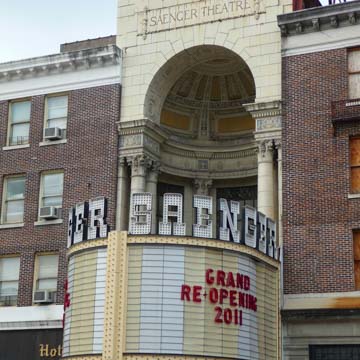In 1911, brothers Julian and A. D. Saenger formed the Saenger Amusement Company, which eventually operated 320 theaters in eleven southern states and the Caribbean. Weil designed several theaters for the Saengers, including those in Cuba, Costa Rica, Texas, Arkansas, and the Saengers’ home town of Shreveport. The New Orleans’ Saenger, which accommodated almost 4,000 people, was, when built, one of the largest theaters in the South. Although the brick exterior of the reinforced-concrete structure is embellished with decorative niches, and the entrance marquee is framed by a triumphal arch motif, the glamorous interior still comes as a surprise. Weil designed a lobby embellished with black and gold marble, mirrors and crystal chandeliers, and a domed ceiling supported on elaborate Composite capitals. This lobby was for white patrons; “colored” patrons entered the theater on its Basin Street side, where stairs led directly to the balcony. The theater’s highpoint is the auditorium, where, according to Southern Architect and Building News, Weil created the fantasy of “an Italian garden; a Persian court; in a Spanish patio.” The auditorium walls were fashioned as building facades in plaster, wood, and marble, with an architectural vista of towers and rooftops lined with classical statues in front of a painted backdrop of exotic plants and birds. To complete the illusion of an outdoor setting, images of slowly moving clouds were projected across a domed ceiling painted deep blue and perforated by hundreds of twinkling pinpoint lights. John Eberson pioneered the atmospheric setting at the Majestic Theater in Houston (1923); Weil, however, credited Chicago’s Capitol Theater as his source. Since the Saenger was designed and built for motion pictures as well as live theater, the auditorium had raked seating and a balcony. On the opening night, moviegoers watched the silent film Blonde or Brunette, accompanied by an 80-piece orchestra and the 778-pipe Morton Mighty Wonder Organ. Flooded in Hurricane Katrina, the theater underwent a complete renovation. The stagehouse was greatly enlarged, and now the Saenger is a venue for various concerts and theatrical events, including major Broadway productions.
You are here
Saenger Theater
1926–1927, Emile Weil; 2013 renovated, Martinez and Johnson Architecture and Ace Theatrical Group. 1111 Canal St.
If SAH Archipedia has been useful to you, please consider supporting it.
SAH Archipedia tells the story of the United States through its buildings, landscapes, and cities. This freely available resource empowers the public with authoritative knowledge that deepens their understanding and appreciation of the built environment. But the Society of Architectural Historians, which created SAH Archipedia with University of Virginia Press, needs your support to maintain the high-caliber research, writing, photography, cartography, editing, design, and programming that make SAH Archipedia a trusted online resource available to all who value the history of place, heritage tourism, and learning.






